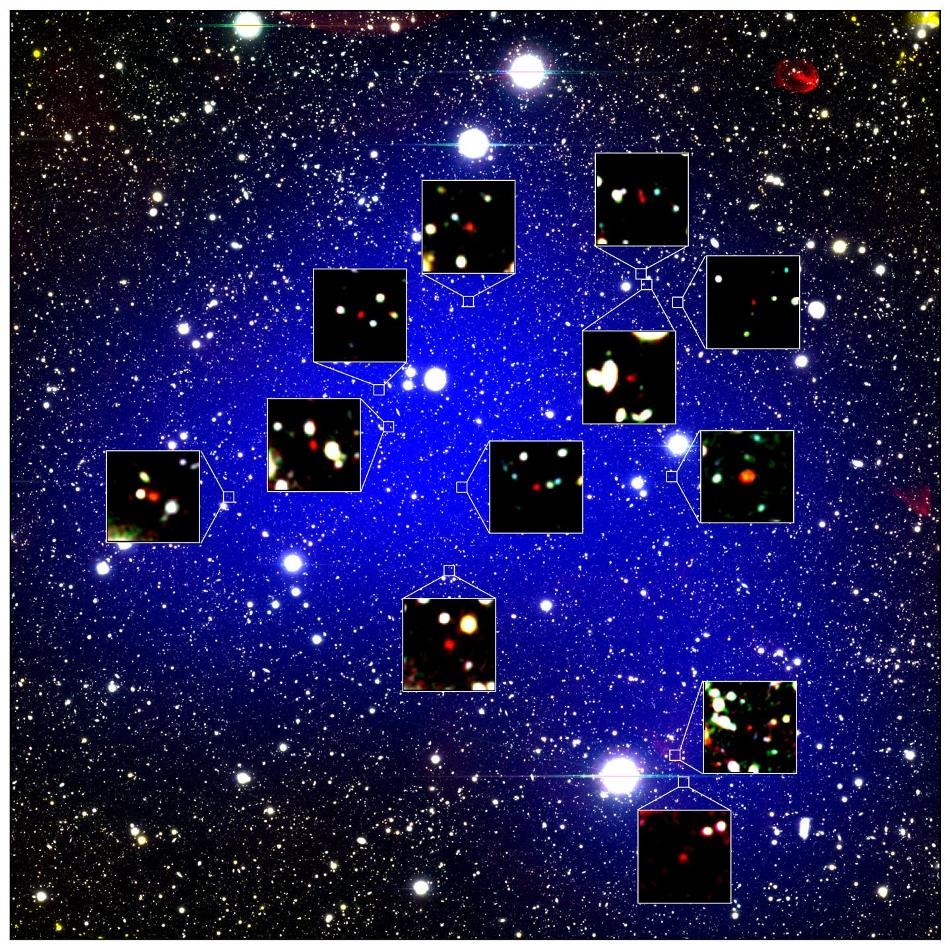Oct 1 2019
An international team of astronomers used the Subaru, Keck, and Gemini Telescopes to discover a collection of 12 galaxies that existed nearly 13 billion years ago. This is the earliest protocluster to ever be discovered.
 The blue shading shows the calculated extent of the protocluster, and the bluer color indicates higher density of galaxies in the protocluster. The red objects in zoom-in figures are the 12 galaxies found in it. This figure shows a square field-of-view 24 arcminutes along each side (corresponding to 198 million light-years along each side at a distance of 13.0 billion light-years). Each zoom-in figure is 16 arcseconds along each side (corresponding to 2.2 million light-years). (Image credit: NAOJ/Harikane et al.)
The blue shading shows the calculated extent of the protocluster, and the bluer color indicates higher density of galaxies in the protocluster. The red objects in zoom-in figures are the 12 galaxies found in it. This figure shows a square field-of-view 24 arcminutes along each side (corresponding to 198 million light-years along each side at a distance of 13.0 billion light-years). Each zoom-in figure is 16 arcseconds along each side (corresponding to 2.2 million light-years). (Image credit: NAOJ/Harikane et al.)
Among the 12 galaxies, one is a giant object called Himiko. The Himiko was discovered 10 years ago using the Subaru Telescope and was named after a mythological queen in ancient Japan. This finding indicates that large structures like protoclusters were already present when the Universe was just about 800 million years old, 6% of its current age.
Although the galaxy clusters in the present Universe can consist of hundreds of members, how these clusters are formed is a huge conundrum in astronomy. In order to gain insights into the formation of clusters, astronomers look for probable progenitors in the ancient Universe. A protocluster is a dense network of dozens of galaxies in the early Universe, expanding into a cluster.
A protocluster is a rare and special system with an extremely high density, and not easy to find. To overcome this problem, we used the wide field of view of the Subaru Telescope to map a large area of the sky and look for protoclusters.
Yuichi Harikane, JSPS fellow, National Astronomical Observatory of Japan
Harikane led the team of astronomers in this study.
In the map of the Universe developed by the Subaru Telescope, the researchers found a protocluster candidate, z66OD, in which galaxies are 15 times more concentrated compared to normal for that era.
Then, the researchers used the W.M. Keck Observatory and Gemini North telescope to perform further spectroscopic observations. They confirmed 12 galaxies that existed 13 billion years ago, rendering it the earliest protocluster known until now.
Fascinatingly, of the 12 galaxies in z66OD, one was a giant object including a huge body of gas, called Himiko, discovered in 2009 by Masami Ouchi and his colleagues with the help of the Subaru Telescope.
It is reasonable to find a protocluster near a massive object, such as Himiko. However, we’re surprised to see that Himiko was located not in the center of the protocluster, but on the edge 500 million light-years away from the center.
Masami Ouchi, Team Member, National Astronomical Observatory of Japan and the University of Tokyo
Ironically, it is said that the mythological queen Himiko also lived isolated from her people. Ouchi added, “It is still not understood why Himiko is not located in the center. These results will be a key for understanding the relationship between clusters and massive galaxies.”